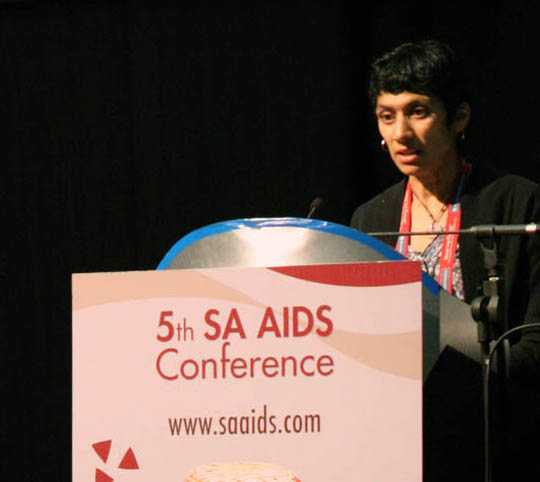PMTCT: A Winnable Battle in South Africa
Related Links
At the 5th South African AIDS Conference in June in Durban, South Africa, South African and CDC researchers presented on new evidence that the country is winning the fight against the HIV and AIDS epidemic. According to their national survey results, the mother-to-child HIV transmission (MTCT) rate for HIV is 3.5% and virtually eliminating this form of HIV transmission is therefore within reach by 2015 with intensified efforts.
“This survey was the first ever rigorous national SA PMTCT evaluation in the nine provinces of South Africa,” said Dr Ameena Goga, Medical Research Council (MRC), as she spoke on behalf of the survey’s principal investigators: herself; Dr. Debra Jackson of University of Western Cape (UWC); and Dr. Thu-Ha Dinh of Centers for Disease Control and Prevention (CDC).
Dr. Goga cautioned that there are still key challenges for virtual elimination that will require intensified efforts.

Dr. Ameena Goga, of the Medical Research Council, presented the findings during the June 2011 conference in Durban. CDC provided technical and financial support for the survey and CDC's Dr. Thu-Ha Dinh was a principal investigator.
“However, we need to address the postnatal component and variabilities in PMTCT service coverage,” said Dr. Goga. “And then reducing the overall MTCT will contribute towards reduction of incident HIV infections at population level.”
The study evaluated the effectiveness of the national PMTCT program at six weeks postpartum and showed that, out of a sample size of 9,915 infants, 31.4% were HIV-exposed. The national HIV transmission rate from mother-to-child was 3.5%, measured in these infants aged 4-8 weeks and attending public sector clinics for their (six week DTaP/Pentaxim) immunization.
The survey was conducted from June to December 2010 by the Health Systems Research Unit of the MRC on behalf of the National Department of Health with support from CDC (both financial and technical support), UNICEF, National Institute for Communicable Disease/National Health Laboratory Services, University of Witwatersrand Infant HIV Diagnostics and UWC.
“The survey highlighted the acceptability of routine infant HIV testing once the advantages were explained” said Dr. Jackson. “Ninety-two percent of eligible caregivers agreed to their infants being tested for HIV”.
Dr Dinh pointed out that 4.1% of infants whose mothers reported being HIV negative were actually exposed to HIV, highlighting the need to strengthen repeat testing during pregnancy and in couples.
“The survey also accentuated gaps in postnatal care and infant follow-up” said Dr Goga. “This emphasizes the importance of tracking MTCT rates until 18 months to measure the effectiveness of the complete PMTCT program.”
The evaluation will be repeated in 2011 and 2012 to track MTCT rates over three years and to follow infants from the 2010 study to measure HIV transmission rates between six week and 18 months.
In 2010 the government revised PMTCT guidelines to include AZT from 14 weeks, highly active antiretroviral therapy for pregnant women with CD4 cell counts less than 350, and infant nevirapine prophylaxis for six weeks (if the mother is on antiretroviral therapy or not breastfeeding) or throughout breastfeeding. The guidelines promote integration of PMTCT services into maternal, newborn, and child health services. This evaluation provides data to track the effectiveness of the revised guidelines.
- Page last reviewed: January 2, 2015
- Page last updated: January 2, 2015
- Content source:
Global Health
Notice: Linking to a non-federal site does not constitute an endorsement by HHS, CDC or any of its employees of the sponsors or the information and products presented on the site.


 ShareCompartir
ShareCompartir